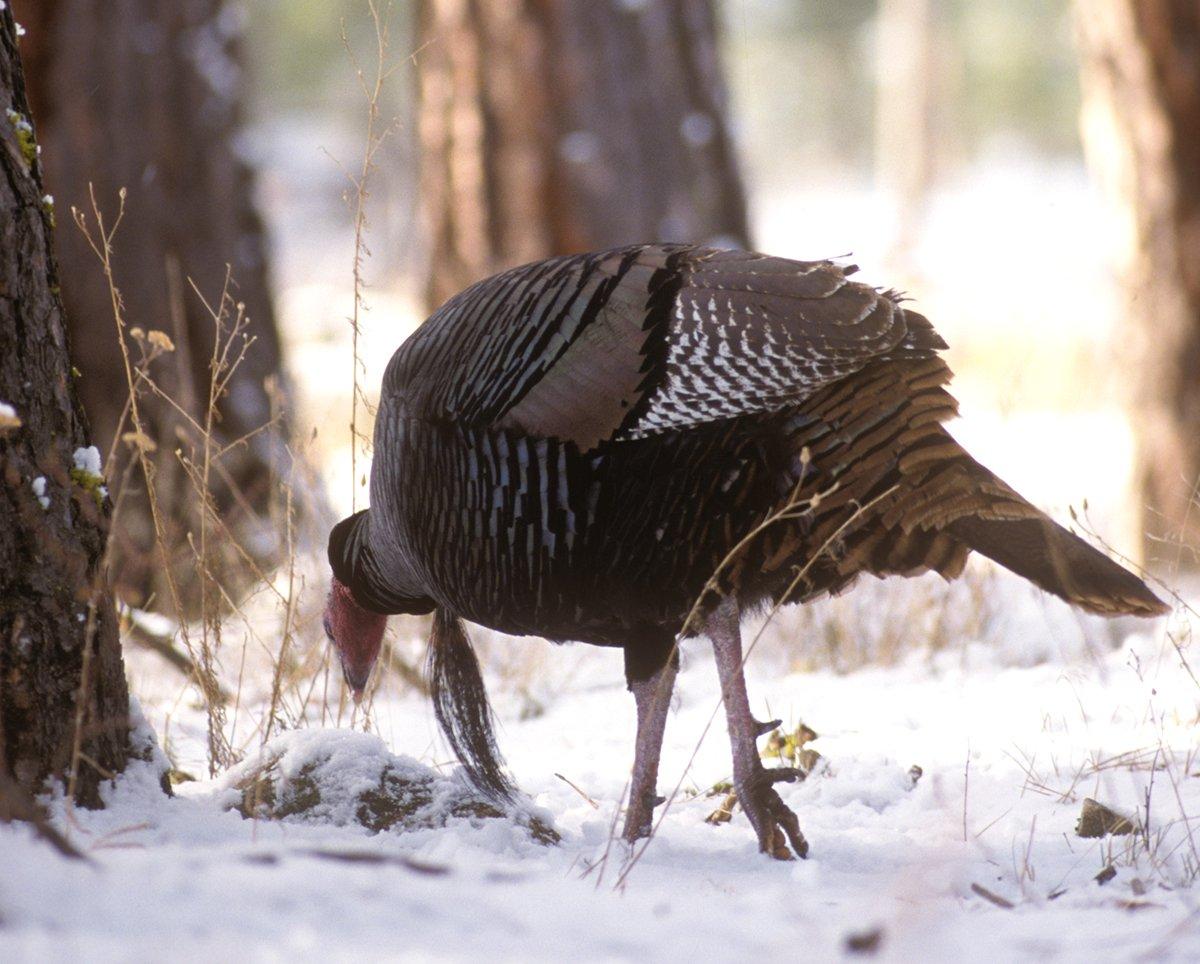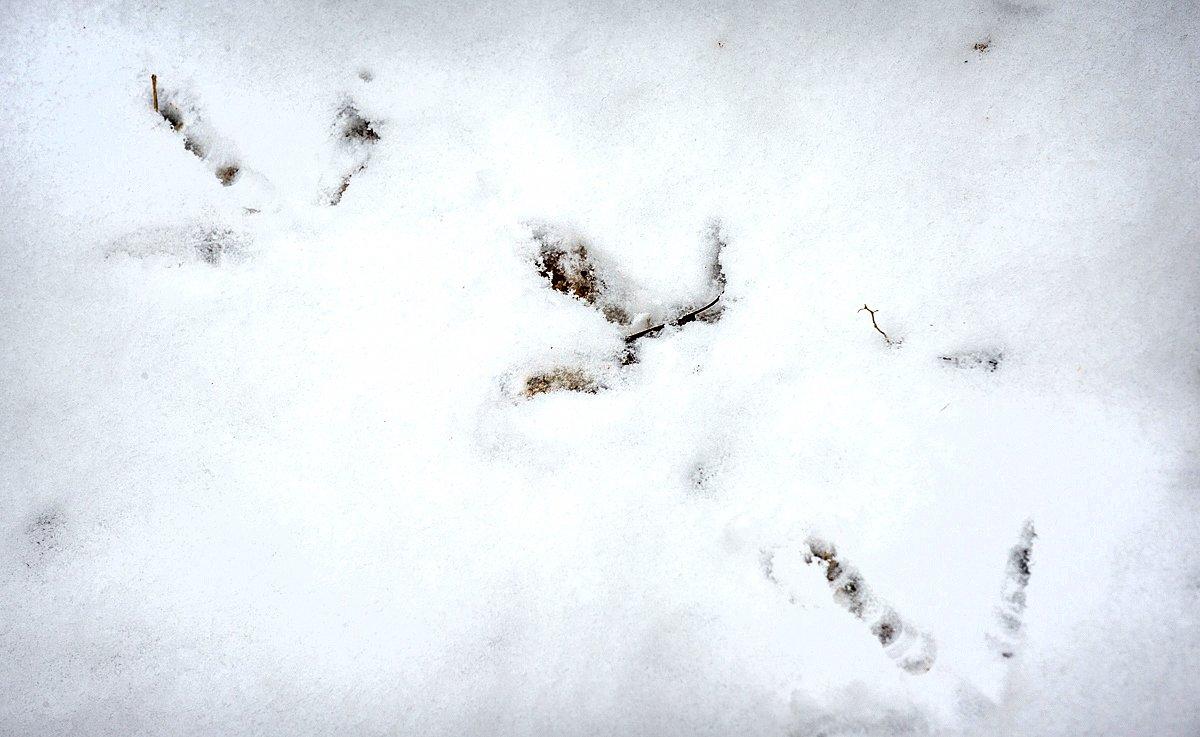Turkey Hunting Isn't Just for Spring
You'll never see more turkeys together than between now and the so-called spring dispersal.
Winter flocks are typically big, from dozens to hundreds of birds, young and old.
This time of the year, turkeys will be concentrated near the best food sources: picked-over crop fields, cow pastures and feedlots (they peck at the cow pies), plus hardwood mast in the woods and along creekbeds (where you might have found wood ducks this past fall).
You'll even see birds hitting food sources such as soft mast, weather providing.
Entire turkey populations, particularly out West in places like Nebraska and Kansas, may group up and shift home ranges this time of year. You've got to study where they go, day by day.
First off, make sure it's legal in your state. Then, get on those winter birds.
Blind Hunting with a Bow
You've got patterned turkeys.
You know what food source they're hitting.
You've staked your pop-up blind near it.
You want to add a look of confidence for turkeys coming into the field or wooded area.
Now you want those turkeys to present a good target.
Decoys, as in spring, can help fix the positions of birds coming into range so you can take a clean, ethical shot on a standing bird.
Truth is, in fall and winter, a bunch of turkeys might just ignore your decoys placed squarely in front of your blind. These birds are often curious though, and some - maybe the one you want - might just wander close.
Now take that killing shot.
Huge Flocks
Abundant birds equal more wary eyes, but also added opportunity.
As the New Year passes, gobbler groups feel spring's pull, especially around all those other turkeys.
Pecking order dominance is a year-round factor, but it starts daily fights this time of year. Use that to your advantage. Learn how to make some aggressive purrs on your slate and you'll be in business. Use this call sparingly and . . .
Find a roosting flock, slip in tight to them before daylight, then imitate a post fly-down rumble.
Hunting Gobbler Gangs
In the fall and winter, gobblers over a year old often run together.
Some are 18-months-old ("super jakes"). Some are even older.
Pecking order, as always, is a factor. They square off. They fight. They keep track of other gobblers slipping into their territory. A red-headed decoy might draw some attention.
If you've scattered a group of fall or winter gobblers, it often takes some time to get them to regroup. You can place standing gobbler decoys (those jake models are great for this), and give real turkeys a visual reference.
Bear in mind, safety rules with turkey decoy use as always.
Place decoys so an errant shot at the mistaken fake might not endanger you, rare as this might be.
In rifle states, avoid use. In shotgun states, or better yet during bow-only hunts, it might just work.
These days, many turkey hunting decoys surely look real. A silhouette of one or more is truly convincing. When combined with our next reason, it's not really such a good idea.
And since so many states offer either-sex fall turkey hunts, some might argue you should leave the turkey decoys home until spring. Period. In the end, if legal, it's your decision.
Be safe. Have fun. Think like a turkey and another hunter seeing the decoys you've set out.
Either-Sex Turkeys
In many of the 42 states permitting fall turkey hunting (and even fewer in winter), either-sex birds are legal to take (but not Florida where it's "gobblers and bearded birds only").
This means it's important to identify your target as a turkey, but less so as a gobbler or hen (unless you're in the Sunshine State).
Still, you may wish to be selective. Some folks don't care for taking legal fall/winter hens. Here are some wild turkey identification tips.
- Hen breast feathers are brown-tipped, while gobblers bear black-tipped chest feathers.
- Male turkeys have brick-red heads, red, white and blue heads and necks (when excited, especially when fighting or strutting), or pink coloring (especially around the eyes in young fall/winter birds of the year).
- Beards are often, but not always, distinguishing characteristics as some hens wear them.
- As always, identify your target, even if you can kill a gobbler or legal hen.
Dog Them
For some of us, fall turkey hunting means covering a lot of ground, often with a dog.
Canine hunting buds, trained to find and scatter turkey flocks, will help.
Calling turkeys, say after a scatter, will allow birds returning to the break site to fix your location.
Decoys optional. Often lonely birds, wishing to regroup, will simply key in on your exact calling location.
Use All Your Decoys
You may need to cover some ground to find fall turkeys, so first make sure you have a good pair of boots.
Next, once there, you might need to visually imitate a bunch of turkeys to get live birds interested, despite their tendency to focus on your calling.
Did you get a few turkey decoys under the ol' Christmas tree? Don't wait until spring to use them. Use them all, old and new.
Load up that big decoy bag and start hunting.
Once there, match your big turkey hunting decoy spread with raspy three-note gobbler yelps, urgent, squawky jake yelps, fighting purrs, high-pitched hen yelps, and even gobbling.
Yelp on a mouth call as you run multiple friction calls. Make some noise, then shut up. As always, think about what those birds might be seeing in your field fakes.
Imitating a Bunch of Turkeys
You won't be able to match the sounds of 100 turkeys by yourself, but you may be convincing enough to watch a dominant bird appear, blow up into strut, and mince steps right into your setup (yep, even in winter, especially now as days begin to grow longer).
You might even call in the whole group.
Bring a buddy or two to help.
Cluck. Yelp. Kee-kee. Even gobble.
Watch. Wait. Then fill your winter turkey tags.
Bonus Read: 5 Ways to Call in the Whole Flock . . .
Go here for more Realtree turkey hunting.
Follow us on Facebook.









